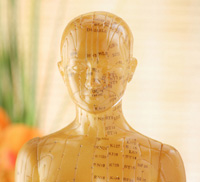Acupuncture research may be minimizing the true value of acupuncture treatments. A new study shows that only 25 percent of randomized controlled studies of acupuncture for the treatment of chronic lower back pain “were rated good in respect to Chinese textbook acupuncture standards.” A group of 15 experts from 9 countries outside China were asked three questions about acupuncture and its use in randomized controlled studies. How does it rate in terms of Chinese textbook standards? How does it rate compared with the individual expert’s style? How does it rate compared with the standard acupuncture procedures in the expert’s country? The study showed similar results with a 25% rating of good for all three questions.
Scientific Acupuncture Research
Acupuncture for the treatment of lower back pain has been proven effective in many scientific studies meeting Chinese textbook standards. Doctors from the University of Maryland School of Medicine, Baltimore and the University of Vermont College of Medicine, Burlington published a case vignette in the New England Journal of Medicine recommending acupuncture for the treatment of lower back pain. The doctors conclude that acupuncture is an effective means for treating lower back pain based partly on a study of 6,359 patients published in Spine1.
The doctors cite physiological phenomena that measure the effects of acupuncture. Local anesthesia at needle insertion sites block the the analgesic effects of acupuncture showing that acupuncture is dependent upon neural innervation2. Acupuncture has been proven to cause the release of endogenous opioids in brain-stem, subcortical, and limbic structures3,4. Acupuncture has also been proven to induce the secretion of adrenocorticotropic hormone and cortisol from the pituitary gland thereby creating a systemic anti-inflammatory response5. Functional MRI studies in humans reveal that acupuncture stimulates limbic and basal forebrain areas involved in pain processing6. PET scan MRIs (positron-emission tomography) show that acupuncture increases opioid binding potential in the brain for several days7. Acupuncture has also been proven to mechanically stimulate connective tissues8, release adenosine at the site of needle stimulation9, and increase local blood blow10. The doctors then cite clinical trials showing the efficaciousness of acupuncture in the treatment of thousands of patients10-15.

Reference:
Molsberger A, Zhou J, Boewing L, Arndt D, Karst M, Teske W, Drabik A. An international expert survey on acupuncture in randomized controlled trials for low back pain and a validation of the low back pain acupuncture score. Eur J Med Res. 2011 Mar 28;16(3):133-8.
Footnotes:
1. Yuan J, Purepong N, Kerr DP, Park J, Bradbury I, McDonough S. Effectiveness of acupuncture for low back pain: a systematic review. Spine 2008;33:E887-E900.
2. Wang SM, Kain ZN, White P. Acupuncture analgesia: I. The scientific ba- sis. Anesth Analg 2008;106:602-10.
3. Han JS. Acupuncture: neuropeptide release produced by electrical stimulation of different frequencies. Trends Neurosci 2003;26:17-22.
4. Pomeranz B. Scientific research into acupuncture for the relief of pain. J Altern Complement Med 1996;2:53-60.
5. Li A, Lao L, Wang Y, et al. Electroacupuncture activates corticotrophin-releasing hormone-containing neurons in the paraventricular nucleus of the hypothalamus to alleviate edema in a rat model of inflammation. BMC Complement Altern Med 2008;8:20.
6. Dhond RP, Kettner N, Napadow V. Neuroimaging acupuncture effects in the human brain. J Altern Complement Med 2007;13:603-16.
7. Harris RE, Zubieta JK, Scott DJ, Napa- dow V, Gracely RH, Clauw DJ. Traditional Chinese acupuncture and placebo (sham) acupuncture are differentiated by their effects on mu-opioid receptors (MORs). Neuroimage 2009;47:1077-85.
8. Langevin HM, Churchill DL, Wu J, et al. Evidence of connective tissue involvement in acupuncture. FASEB J 2002;16:872-4.
9. Goldman N, Chen M, Fujita T, et al. Adenosine A1 receptors mediate local anti-nociceptive effects of acupuncture. Nat Neurosci 2010 May 30 (Epub ahead of print).
10. Sandberg M, Lundeberg T, Lindberg LG, Gerdle B. Effects of acupuncture on skin and muscle blood flow in healthy subjects. Eur J Appl Physiol 2003;90:114-9.
11. Brinkhaus B, Witt CM, Jena S, et al. Acupuncture in patients with chronic low back pain: a randomized controlled trial. Arch Intern Med 2006;166:450-7.
12. Haake M, Muller HH, Schade-Brittinger C, et al. German Acupuncture Trials (GERAC) for chronic low back pain: randomized, multicenter, blinded, paralel-group trial with 3 groups. Arch Intern Med 2007;167:1892-8. [Erratum, Arch In- tern Med 2007;167:2072.]
13. Cherkin DC, Sherman KJ, Avins AL, et al. A randomized trial comparing acupuncture, simulated acupuncture, and usual care for chronic low back pain. Arch In- tern Med 2009;169:858-66.
14. Thomas KJ, MacPherson H, Thorpe L, et al. Randomised controlled trial of a short course of traditional acupuncture compared with usual care for persistent non-specific low back pain. BMJ 2006; 333:623.
15. Witt CM, Jena S, Selim D, et al. Prag- matic randomized trial evaluating the clinical and economic effectiveness of acupuncture for chronic low back pain. Am J Epidemiol 2006;164:487-96.

